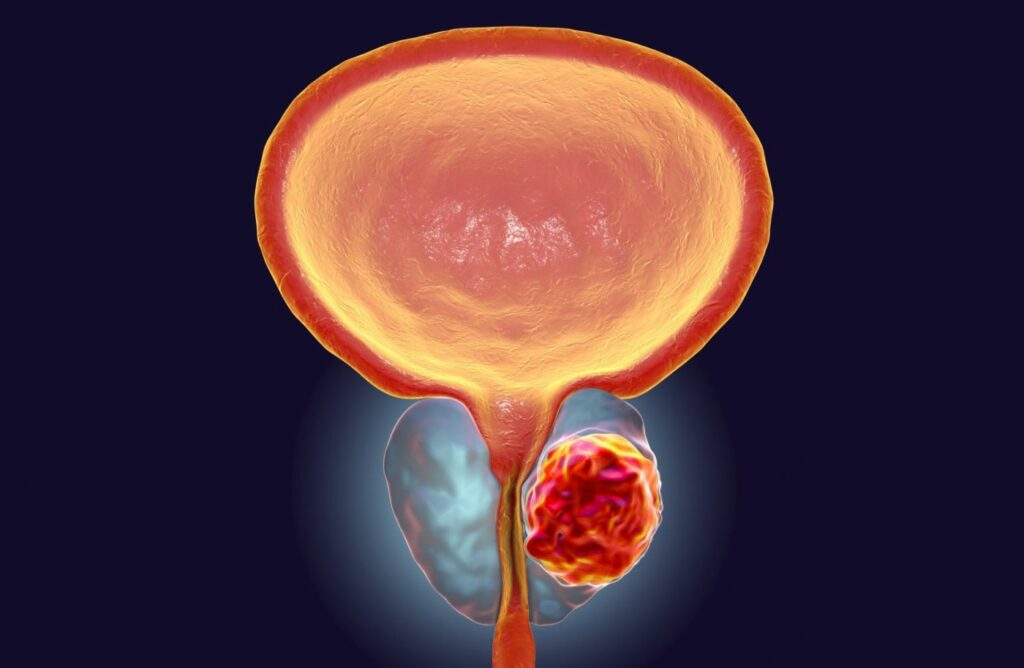Anasayfa » Prostate Cancer
Doç. Dr. Mehmet Ali Karagöz

Prostate Cancer
Prostate cancer is a cancer that develops from cells in the prostate gland. It is the most common type of cancer in men after lung cancer in the world. Approximately 1 in 8 men will be diagnosed with prostate cancer in their lifetime. Although the exact cause of prostate cancer is unclear, some risk factors increase the chance of developing prostate cancer.
What are the risk factors for prostate cancer?
- Age
- Family history and genetic factors (father, uncle or brother with prostate cancer at an early age) are among the factors that increase the risk.
- Race-Ethnicity
- Obesity is a risk factor for advanced prostate
- Diet is probably a risk As with other cancers, a diet high in fat and low in fruits and vegetables may increase the risk.
What are the symptoms for prostate cancer?

- The urine flow rate may slow down and it may take longer to empty your
- You may need to wait on the toilet for a while before you start
- As soon as you finish using the toilet, a little more urine may leak and stain your
- You may urinate more frequently than
- You may need to go to the toilet quickly due to a sudden feeling of
- You may have the feeling that you have not fully emptied your
Note: All of the above prostate cancer symptoms are common in older men. Most men who develop the above symptoms do not have prostate cancer, but may have a non-cancerous (benign) growth on the prostate. However, it is best to have checked any new symptoms by a doctor.
If cancer spreads to other parts of the body, other symptoms may develop. The most common area for cancer to spread is bones. It can especially spread to the hip bone, spine and ribs. Affected bones
may become painful and tender. Sometimes the first symptoms that develop may be due to pain and bone fractures caused by the tumor spreading to the bones.
How is prostate cancer diagnosed?
Prostate cancer screening is performed by a urologist starting from the age of 40-45 in the risk group due to family history and genetic factors, and from the age of 50 in the normal population. The diagnosis of prostate cancer is made with a prostate biopsy performed after a number of tests and examinations.
Digital rectal examination
The size and consistency of the prostate and the presence of hard nodular structures are evaluated by finger examination of the outer surface of the prostate from the anal area. With this examination, lesions suspicious for cancer can be noticed. If suspicious lesions are found, your doctor may recommend a prostate biopsy. However, a prostate gland that feels normal does not rule out prostate cancer.
Prostate specific antigen (PSA) measurement
Prostate-specific antigen (PSA) is a chemical made by both normal and cancerous (malignant) prostate cells. To measure the PSA level, a blood test is performed after the age of 45 in risky individuals and after the age of 50 in normal individuals. The higher the PSA level, the more likely you are to have prostate cancer. However, a mildly to moderately elevated PSA may occur in conditions other than prostate cancer (prostate infections, severely enlarged prostate volume, prostate examination, urological procedures).
Multiparametric MRI
Multiparametric magnetic resonance imaging (mp-MRI) is a relatively new scanning technique that produces a detailed image of the prostate. It is approved by the National Institute for Health and Care Excellence (NICE) and can prevent unnecessary biopsies for low-risk cancer patients. It is hoped that the system will make it easier to detect cancers earlier and reduce the need for further treatment.
When do we take biopsy from prostate?
In cases of suspicion of prostate cancer, a biopsy is taken by sampling the prostate gland using a thin needle. This is usually done with the help of a special ultrasound. With the developing technology in recent years, multiparametric MR images and ultrasound images have been matched, providing the opportunity to perform biopsies from areas with high cancer suspicion. With this method, the rate of detecting existing prostate cancer increases from 65% to over 90%. In our clinic, MRI Fusion biopsy is performed under local or general anesthesia from the perineal area, which has the lowest risk of infection.
How is prostate cancer treated?
There are many different methods in the treatment of prostate cancer.
Surgical treatment (radical prostatectomy), radiotherapy, hormone therapy and, less frequently, chemotherapy or follow-up options are possible. When deciding on these treatments, the stage of prostate cancer, its aggressiveness, whether it has spread in the body, and the general condition of the patient are taken into consideration.
What are the treatment options for prostate cancer?
Active Surveillance: With this option, it is aimed to monitor low-stage cancers and avoid side effects and complications of the treatments the patient will receive. Follow-up or selection of the appropriate treatment is provided according to the stage of your disease, with frequent checks recommended by your doctor.
Surgical Treatment-Radical Prostatectomy: With this surgery, the prostate gland and its appendages are completely removed. Treatment is usually accompanied by removal of surrounding lymph tissues. This surgery can be performed open, laparoscopically and robotically.
Radiotherapy: Cancerous cells are destroyed by radioactive rays. While it may be sufficient alone in low-stage prostate cancer, it can also be applied alone or as part of the treatment in more advanced stages.
HIFU (High intensity focused ultrasound): This treatment is one of the non-surgical prostate cancer treatment methods that has become increasingly common in recent years for patients with early stage prostate cancer. The prostate cancerous tissue is targeted with a probe inserted from the anus and the cancerous area is destroyed with 85-100 degree heat. In this way, complications such as urinary incontinence and erection problems are avoided.
Hormonal treatment: There is a relationship between androgens (testosterone, dihydrotestosterone) produced in the body and the development and progression of prostate cancer. With this treatment, androgen hormones in the body are suppressed and the development and spread of cancerous cells is slowed down. It is often used in addition to other treatments for prostate cancer that has spread to the bone and body.
Chemotherapy: If prostate cancer has spread (metastasized) to other parts of your body, chemotherapy may be included in the treatment together with anti-androgen drugs.
In the treatment of prostate cancer, as in every cancer treatment, the treatment plan is decided by taking into account many factors depending on the patient, the stage and aggressiveness of the cancer. You can consult your urologist for detailed information.
Detailed information and appointment: 0532 424 6032

Doç. Dr. Mehmet Ali Karagöz
Üroloji Uzmanı
İletişim Formu
Bize iletişim formu üzerinden ulaşabilirsiniz.
